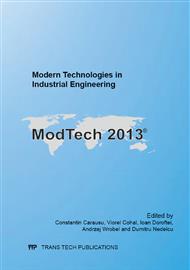p.110
p.116
p.122
p.128
p.135
p.141
p.147
p.152
p.158
The Influence of Burnishing Parameters on the Surface Quality of Bars Made from AZ61 Magnesium Alloy
Abstract:
In the machining of the magnesium and magnesium alloys, some difficulties are encountered during working process. Thus, in the case of turning operation, when phenomena like: splinter self-ignition and flank built-up occur during machining, special tools and coolants are required in order to diminish the effects of such phenomena. In the case of grinding operation of the magnesium and its alloys, other phenomena like: adhesion between the abrasive tools and processing materials can cause explosions and hence such operation must be conducted in special conditions. A solution that can be applied to avoid such phenomena and effects is represented by the utilization of the burnishing operation. In the present study, the influence of the burnishing process on the quality of the machined surfaces of parts made from AZ61 magnesium alloy was performed. The quality of the burnished surfaces was analyzed in terms of the roughness and hardness parameters, the parameters with the greatest influence on surfaces roughness and hardness being the burnishing feed, burnishing speed and burnishing pressure
Info:
Periodical:
Pages:
135-140
Citation:
Online since:
November 2013
Authors:
Keywords:
Price:
Сopyright:
© 2014 Trans Tech Publications Ltd. All Rights Reserved
Share:
Citation:


